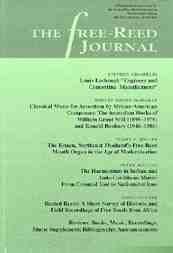
Five Articles:
Four Reviews:Maria Dunkel: Buttons and Codes: Ideographies for Bandoneon and Concertina as Examples of alternative Notational Systems in Nineteenth-Century Germany
Edwald Henseler and Satoshi Murao: Some Notes on the Suifukin: A Reed-Pipe in Late Meiji-Era Japan
Cathy Ragland: "With his Accordion in his Hand": The Impact of the Accordion during the Formative Years of Modern Texas-Mexican Conjunto Music (1930s-1950)
James P. Cottingham: The Acoustics of the American Reed Organ
Allan W. Atlas: Concertinas 1998-1999: A (Brief) Review-Essay
Two Music Scores:Books: Akkordeon-Bandoneon-Concertina im Kontext der Harmonika-instrumente, Maria Dunkel
Recordings:
Sigfid Karg-Elert: Compositions for Harmonium, Helmut Jacobs, accordion
Said and Done Flaco Jimenez, accordion
Los Grandes Badoneones de la Guardia Vieja y la Epoca de Oro del Tango
the wind blows inside for solo khaen by Christopher AdlerPublished: 2001
Serenade for concertina and pianoforte by Bernhard Molique
Published by Pendragon Press http://www.pendragonpress.com
PO Box 190
Hillsdale, NY 12529
Fax: 518-325-6102
email: penpress@-aconic.net
Review by Henry Doktorski:
Although this issue of The CSFRI Free-Reed Journal was delayed (it was originally supposed to have been published in 2000) I think the quality of the journal made the wait worthwhile. The articles seem to be shorter than the articles in volume 1 (the journal has 20% less pages this year) but this issue was just as enjoyable and educational as the first.Maria Dunkel presents a fascinating discourse on the development of the tablature method of notation for bandoneon and concertina, with examples from tablature books from the turn of the last century. She draws interesting conclusions about modern music notation: "As elements of standard musical notation encroach upon the code in order to render it more precise, they inhibit the free flow of regional styles and traditions and individual and collective tastes into the performance." This parallels my study of Gregorian chants: when the 5 line staff with corresponding note values, i.e.. whole, half, quarter, eighth, etc., was introduced in the 11th century, the subtleties of chant performance were lost.
Have you ever heard of the Japanese free-reed pipe, the Suifukin? Ewald Henseler and Satoshi Murao provide an interesting description and history of this archaic instrument which played an important role in the Japanese acceptance of Western music.
Cathy Ragland's article about the history of the modern Texas-Mexican conjunto ensemble describes the careers of three accordionists: Narciso Martinez, Santiago Jimenez, Sr., and Tony de a Rosa.
James P. Cottingham contributes a technical tome about the acoustics of the American Reed Organ which includes diagrams and graphs of amplitude of reed vibration vs. blowing pressure, reed displacement and sound pressure wave forms, spectrum analyses, etc.
Allan W. Atlas provides a (brief) review-essay drawing attention to modern facsimile editions of 19th-century concertina music and tutors, as well as a summary of new music for concertina and a few short CD reviews.
Rounding out the volume are several reviews and music supplements (one review written by The Classical Free-Reed, Inc. staff writer Gregory Vozar).
I found The Free-Reed Journal, vol. 2 just as interesting as the first issue. In fact, I found it easier to read, as the articles were shorter. Certainly all classical free-reed lovers should have standing subscriptions for this scholarly and important resource.
| About The Free-Reed Review |
| Invitation to Contributors / Submission Guidelines |
| Back to The Free-Reed Review Contents
Page |
| Back
to The Classical Free-Reed, Inc. Home Page |